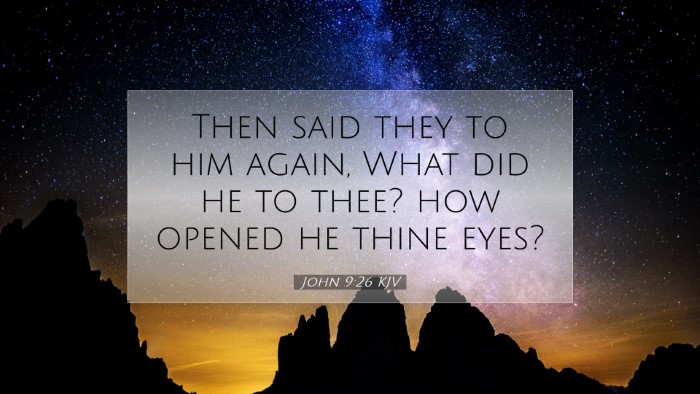Commentary on John 9:26
In the Gospel of John, the ninth chapter tells the compelling story of Jesus healing a man born blind. John 9:26 presents a pivotal moment in this narrative, where the Pharisees interrogate the healed man's experience with Jesus. This commentary draws from several public domain sources, including the insights from Matthew Henry, Albert Barnes, and Adam Clarke, to highlight the theological implications, contextual relevance, and spiritual lessons found in this verse.
Contextual Background
John 9:26 states:
“Then said they to him again, What did he to thee? how opened he thine eyes?”
This inquiry is part of a larger dialogue following a miraculous healing. The Pharisees, who were deeply invested in maintaining their interpretations of the law and traditions, are confronted with a miracle that challenges their understanding and authority.
Exegesis and Analysis
Pharisees' Opposition
According to Matthew Henry, the repeated questioning by the Pharisees reveals their obstinacy and refusal to acknowledge the undeniable miracle performed by Jesus. They were not merely seeking clarification; they were attempting to discredit the miracle and the healer. Henry notes that this questioning is indicative of a heart hardened against the truth.
Impact of the Miracle
Albert Barnes emphasizes that the miracle of healing the blind man was significant beyond physical restoration; it served as a manifestation of Jesus' divine authority and mission. Jesus, by giving sight to the blind, fulfilled the prophetic scriptures that described the Messiah's work. In this context, the man's testimony stands against the religious leaders' skepticism and serves to affirm Christ's identity.
The Healed Man's Response
Adam Clarke points out the irony present in this dialogue. The healed man, once blind, now sees not only in the physical sense but also begins to grasp spiritual truths about Jesus' identity. Clarke notes that the man's ultimate discovery of who Jesus is signifies the journey of faith. Initially, he knows Jesus only as the one who healed him, but this event leads him towards deeper understanding.
Thematic Insights
Faith in Adversity
This verse exemplifies how faith is often tested in the face of opposition. The healed man, although confronted by powerful figures, shows steadfastness in his testimony. As Henry suggests, this illustrates a principle of Christian life: true faith may provoke questioning, but it remains unwavering in the presence of doubt.
Transformation Through Christ
The progression of the formerly blind man reflects a broader theological theme of transformation. The physical healing serves as a metaphor for spiritual enlightenment. Both Clarke and Barnes underline that coming to know Christ involves a journey, and each step towards understanding is significant. Spiritual sight, as a gift from God, is both humbling and liberating.
The Nature of Inquiry
The Pharisees' line of questioning raises important considerations about belief and skepticism. Barnes articulates that their inquiries reveal an unwillingness to accept the divine work at hand. This encounter can remind contemporary readers about the dangers of rigid interpretations of faith that reject new revelations of God's activity.
Lessons for Today
- Encouragement to Testify: Just as the healed man was willing to share his experience, believers are encouraged to testify boldly about God's work in their lives, even when faced with opposition.
- Understanding Spiritual Sight: Growing in faith involves recognizing that spiritual sight is a process, and each revelation brings one closer to understanding the fullness of Christ.
- The Challenge of Authority: The verse invites reflection on how modern-day faith communities deal with authority and tradition, challenging readers to remain open to God’s transformative power.
Conclusion
John 9:26 serves as a reminder of the complexities surrounding faith and healing. As believers navigate their journeys, the teachings derived from this verse and surrounding context encourage them to maintain steadfastness in faith, identity in Christ, and a willingness to engage deeply with the truths of the Gospel. The dialogue between the healed man and the Pharisees results not only in personal testimony but also emphasizes the overarching need for spiritual awakening and recognition of Christ's saving power.


